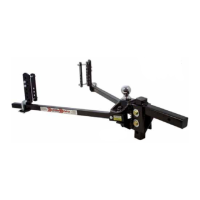21
A product of
Figure 15
NOTE: Tow vehicle wheelbase signicantly effects how the tow
vehicle reacts to weight distribution adjustments. Shorter tow vehicles
move farther up or down than longer ones with the same washer or L-
bracket change. You may not notice much movement at all in the front
end of a long tow vehicle, while a short tow vehicle may raise or drop
signicantly.
Under adjustment occurs when there is not enough weight being transferred
to the front axles of the tow vehicle. See Figure 15.
If the FRONT of your tow vehicle is still higher than the unloaded
height you are most likely still under adjusted. If the FRONT height of your
tow vehicle is just barely below the unloaded height, you may be able to
improve handling by increasing the amount of weight you are transferring.
With an under adjusted setup your hitch is not giving back as much steer-
ing control as it could, nor is it providing as much friction as it could to help
reduce trailer sway.
To correct under adjustment you must add more weight distribution
force to the hitch by adding spacer washers, or raising the L-brackets.
If this is the initial set up, use the tongue jack to unload the spring arms.
Remove the spring arms from the hitch head. Uncouple the trailer and pull
tow vehicle forward. Loosen the angle set bolt and add a spacer washer.
Repeat steps 4 and 5 to re-adjust and check weight distribution.
If you have reached the maximum number of spacer washers, or if ad-
justing temporarily due to a change in vehicle loading, use the tongue jack to
unload the spring arms. Raise the L-brackets 1 hole. Move the spring arms
back over the L-brackets and retract the tongue jack. Re-measure the wheel
wells and check for proper weight distribution.
Repeat Steps 5 and 6 until the measurements show that the hitch is dis-
tributing weight well.

